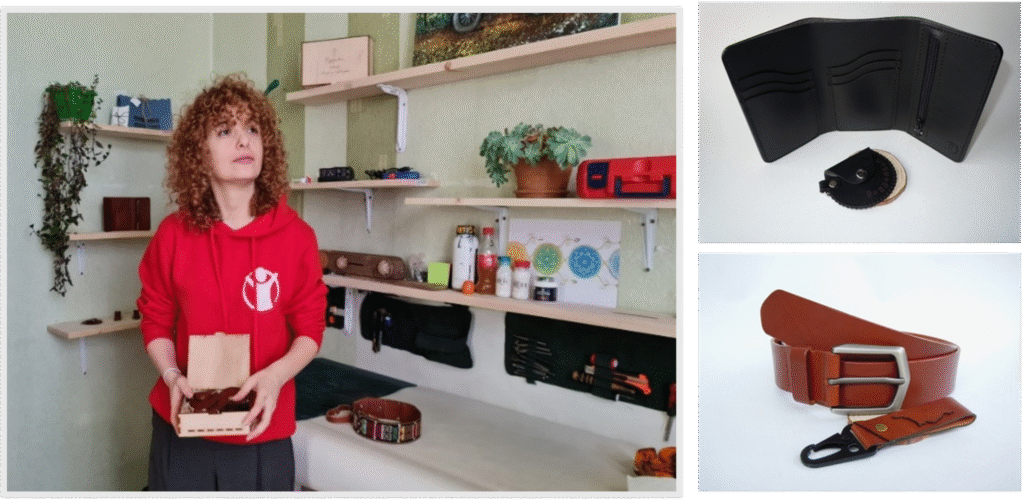
The Problem and Motivation Behind
“In our region, there were no handmade leather products … We wanted to introduce something new—recycled leather coloured with vegetable-based dyes. It gives me a lot of pleasure to think we are creating something ecologically clean… ” – Lika.
Lika Lefsveridze (35-year-old) and her sister Irina live in Akhmeta, a small town in eastern Georgia. They grew up with a love for handmade leather products, inspired by their grandfather who used to make them. But today, they noticed that such crafts have disappeared from their town. At the same time, they became aware of growing concerns about the environmental and health effects of modern leather products, especially because of the toxic chemical dyes often used. These dyes can pollute water sources and cause allergic reactions for both the makers and the users.
Motivated by their passion for handmade leather products and concerns about the environmental impact of chemical dyes, Lika and her sister decided to revive their grandfather’s craft—this time using vegan leather[1] coloured with natural, plant-based dyes.
The Innovative Solution
“At first, working with this type of vegan leather was difficult. It’s different from the chemical one … I wanted to create something that’s both beautiful and responsible … With vegetable-based dyes from leaves and wood, and even hypoallergenic glue, everything we make is biodegradable.” – Lika.
When Lika and her sister, Irina, joined the Youth Innovation Lab, they chose to explore how to make sustainable and eco-friendly leather products. Through a Desing Thinking process, the started by experimenting with vegan leather, plant-based dyes and non-chemical glue. They learned how to handle work with these new materials without waste. They created a wallet prototype and used new machinery to significantly cut down on waste.
Their innovation lies in replacing chemical processes with eco-friendly alternatives. They use vegetable tanning—a method that employs natural tannins from plants—to create beautiful, hypoallergenic products that are gentle on the skin and the environment. When they first introduced their vegan leather products, customers were hesitant. But over time, they were convinced by the products’ quality and uniqueness . “People get curious, and once they try it, they love it,” said Lika.
This positive feedback encouraged them to launch launched a line of vegan leather accessories. Today, 35% of their production is eco-friendly, and they’re already planning to increase that share. Their work has brought attention to sustainable fashion and built a new consumer base that values vegan leather.
Lessons Learned and Addressing Challenges
“It made us much more independent—we no longer rely on external companies for printing or tools. We even give masterclasses now.” – Lika.
The Youth Innovation Lab (YIL) played a key role in supporting Lika and Irina by providing a seed grant, training, and ongoing feedback. This support empowered them to experiment with new ideas and grow their business with confidence. They were able to purchase new machinery, which helped them reduce waste, save time, and improve the quality of their products. Equally important was the mentorship they received, which helped them build skills in business management, product development, and community engagement. “The mentors gave us great feedback. It helped us improve and really believe in what we were doing,” Lika shared.
With this support, they were able to scale up production and become more self-sufficient. They also began training other young women, sharing their knowledge and skills, and inspiring interest in sustainable design and eco-friendly entrepreneurship.
Reflecting on their experience, Lika identified a major lesson learned:
- Raising awareness and dialogue with customer is essential to change their perception and convince them about new products and innovations: To encourage customers to shift away from chemically treated leather, Lika and Irina had to raise their awareness and change their perceptions about eco-friendly leather products. As Lika put it, “People are used to what they know, but when we take the time to show them and explain, they start to understand.” Their journey highlights the importance of education, patience, and open dialogue when promoting sustainable innovation.
Next Steps and Future Aspirations
“We have small space now, but we want to keep sharing what we know… If we can influence even a few people, it’s worth it … we’re changing lives—one wallet, one bracelet, one conversation at a time.” – Lika.
Looking ahead, Lika and Irina are focused on expanding their line of vegan leather accessories. Their ambition is to increase the share of biodegradable materials in their production and continue raising awareness about sustainable fashion. They plan to grow their network, offer training for other to share their knowledge and skills. In the long term, they envision a workshop that not only produces sustainable accessories but also serves as a community hub for learning and collaboration.
[1] Vegan leather is a type of material designed to look and feel like real leather, but it’s made without using any animal products. Unlike traditional leather, which is made from animal hides, vegan leather is created from plant-based materials, such as pineapple leaves (Piñatex), apple peels, mushrooms (mycelium), or cactus.